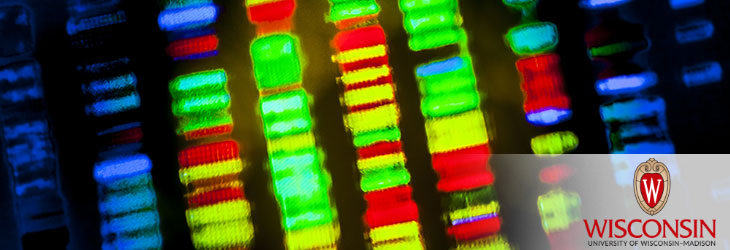Diagnostics & Biomarkers

Detecting Circulating Tumor DNA at Very Low Levels
WARF: P230118US01
Inventors: Muhammed Murtaza, Bradon McDonald, Kirsten Dennison
The Wisconsin Alumni Research Foundation is seeking commercial partners interested in developing a method of quantifying genetic breakpoints in circulating tumor DNA that can be used to monitor residual cancer as well as detect cancer at very early stages.
Overview
Minimal Residual Disease (MRD) detection assays such as those used to detect the presence of cancer at early stages have largely relied on single nucleotide variant (SNV) detection in plasma DNA. While several improvements have been made, the reliability and trust when tumor fractions fall below 0.01% is low. SNVs that arise due to genome arrangements that are precisely located at known breakpoints are far more reliable and cleaner in signal than current methods. So far, this has not been successfully leveraged due to challenges of assaying multiple patient-specific variants at scale.
Structural Variant Enumeration (SVEN) addresses this problem because it uses a sequencing-based approach rather than digital PCR assays and qPCR assays that require far more optimization. The innovation lies in limited cycles with a primer pool, followed by a universal library prep and relative quantification using housekeeping targets. Unlike SNV assays that are affected by background DNA in samples that are not well processed for circulating tumor DNA (ctDNA) analysis, structural variant assays only amplify tumor-derived fragments.
Structural Variant Enumeration (SVEN) addresses this problem because it uses a sequencing-based approach rather than digital PCR assays and qPCR assays that require far more optimization. The innovation lies in limited cycles with a primer pool, followed by a universal library prep and relative quantification using housekeeping targets. Unlike SNV assays that are affected by background DNA in samples that are not well processed for circulating tumor DNA (ctDNA) analysis, structural variant assays only amplify tumor-derived fragments.
The Invention
UW-Madison researchers have developed a method of quantifying genetic breakpoints in circulating tumor DNA that is relatively simple and can be completed in less than a day. This method is sensitive enough to detect circulating tumor DNA (ctDNA) at very low levels and thus can be used to monitor residual cancer or find early-stage cancer.
SVEN involves sequencing a patient’s tumor biopsy, comparing it to a reference genome sequence, identifying the genetic breakpoints in the tumor genome, and creating a panel of primers specific to the structural variants in the tumor biopsy. A key feature of this method is the primer development step and how primers are designed to quantify breakpoints in the ctDNA. Once the researchers identify primer pairs specific for structural variants in the tumor cells, they use the primer panel to amplify the structural variant sites in a patient’s blood DNA along with five housekeeping genes that act as internal standards and are used to quantify the structural variant levels in the patient sample. If the DNA in the blood contains the structural variants, the patient’s cancer is still present or returning. This method is sensitive enough to detect cancer at very early stages.
SVEN involves sequencing a patient’s tumor biopsy, comparing it to a reference genome sequence, identifying the genetic breakpoints in the tumor genome, and creating a panel of primers specific to the structural variants in the tumor biopsy. A key feature of this method is the primer development step and how primers are designed to quantify breakpoints in the ctDNA. Once the researchers identify primer pairs specific for structural variants in the tumor cells, they use the primer panel to amplify the structural variant sites in a patient’s blood DNA along with five housekeeping genes that act as internal standards and are used to quantify the structural variant levels in the patient sample. If the DNA in the blood contains the structural variants, the patient’s cancer is still present or returning. This method is sensitive enough to detect cancer at very early stages.
Applications
- Detecting ctDNA in patients with early-stage cancers at very low tumor fractions
- Monitoring residual cancer
- Quantifying both tumor fraction and estimated tumor fragments per ml of plasma
Key Benefits
- Primer design and resulting amplification steps provide the sensitivity needed to detect cancer at early stages.
- Approach is logistically simpler than existing assays and expected to achieve higher accuracy and tumor specificity.
- Method is expected to unlock sample banks from existing clinical trials of early-stage cancer patients and ease the stringent requirements for sample processing.
Stage of Development
While current results are proof-of principle, demonstration of the approach is now being extended to 20+ patients with breast cancer, identifying SV breakpoints from their FFPE tumor biopsies and using SVEN to detect/measure ctDNA in pre-treatment plasma DNA samples.
Additional Information
For More Information About the Inventors
Tech Fields
For current licensing status, please contact Rafael Diaz at [javascript protected email address] or 608-960-9847